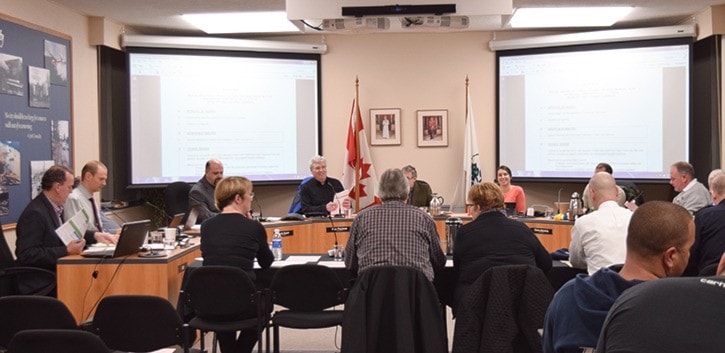The Port Alberni fire department may be looking at fewer firefighters on shift in the next five years in order to reduce costs, according to the city’s 2017-2021 financial plan.
Discussions around the fire department’s budget took almost an hour out of a more than four-hour round table city council budget meeting last week, where council members asked questions of department heads to determine the best way to go forward with the budget draft. Discussions about the city’s capital projects for 2017 will carry forward into the town hall meeting this Wednesday, Feb. 15, 6:30 p.m. in council chambers.
In his presentation to council on Feb. 1, city CAO Tim Pley pointed out that fire department employee costs are 90 percent of the department’s budget. “There is nowhere to go to make a reduction except employees,” he said.
In order to avoid exponential tax increases, the budget plan envisions reducing one firefighter position by attrition by 2017, and another by attrition by 2020. This would result in some occurrences of shifts being staffed by fewer than four personnel.
As fire Chief Kelly Gilday explained during the Feb. 8 round table meeting of council, firefighters must enter a building by a team of two. One person has to remain outside in order to perform a rescue if needed until help comes, and the fourth person is a pump operator who cannot act as a rescue person. With fewer than four personnel on staff, firefighters might be forced to wait to enter a building.
“The mini-mall fire that just happened on Redford there, when the barbershop was on fire, the crew arrived on scene, four guys were there, they were able to enter the building, get to the fire right away and put it out before it affected the roof of the structure,” said Gilday. “Had we not had the fourth guy, we would have lost a whole lot of businesses.”
Gilday also pointed out, “We have the ability to split our crews right now, we can send one out on a medical call and keep two back. So we have them ready to do simultaneous calls. So when we go down to three men, that will change.”
Gilday estimated there will be around 140 shifts with three staff in 2017. “It’ll be our hardest year because it will be our first introduction to this,” he said. “And then we’ll manage it a little better.”
Some councillors expressed concern over public safety, including Coun. Denis Sauvé.
“If it comes to any of the budgets, the one concern I had was the one that you came up with,” he said to Gilday. “We’re all doing constraints with our budget cuts, and I know that and I understand that, but when it comes to public safety, it’s something that we should not be even questioning.
“I would like to see a budget coming back from yourself to respect the firefighter plan with a minimum of four men coverage,” Sauvé suggested. “When it comes to public safety, it’s something that we cannot play with. Come back with a true reflection of what our town needs.”
Councillors Sharie Minions and Jack McLeman questioned the possibility of part-time or volunteer work to make up for the lack of full-time firefighters.
“The model that we have now is probably the most efficient model for a department our size anywhere in the province,” said Gilday. “I read the report from 2012, and we are the cheapest in the Valley. We have the benefit right now with our automatic and mutual aid agreements to have almost regional service, if I can use that term, without the cost of it.”
He compared Port Alberni’s fire department to the one he came from in Langley, which used paid, on-call and volunteer work. He pointed out that the cost for training and new gear made them expensive for a service that isn’t necessarily consistent.
“Volunteers are great to supplement a core service, but you can’t rely on it to always have enough firefighters or enough staffing to be able to do something,” he said. “It’s a great model, it’s not free, it’s a great model to complement what we have, but that model we have now is probably the most efficient model.”
elena.rardon@albernivalleynews.com
facebook.com/albernivalleynews
